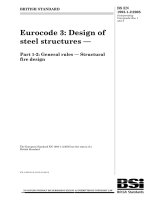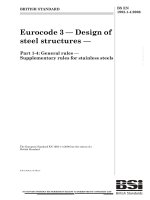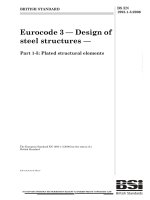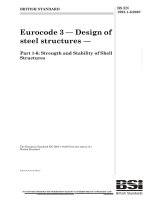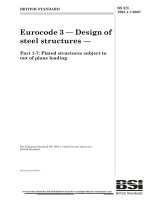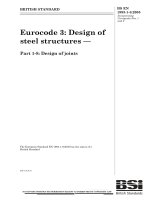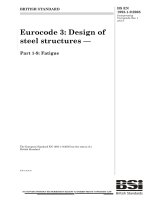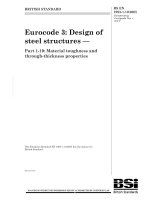Tiêu chuẩn Châu Âu EC8: Kết cấu chống động đất phần 6: Thiết kế tháp, ống khói (Eurocode8 BS EN1998 6 e 2005 Design of structure for earthquake resistance part 6:Towers, masts and chimneys)
Bạn đang xem bản rút gọn của tài liệu. Xem và tải ngay bản đầy đủ của tài liệu tại đây (583.08 KB, 52 trang )
BRITISH STANDARD
Licensed copy:UNIVERSITY OF SURREY, 23/11/2007, Uncontrolled Copy, © BSI
Eurocode 8 — Design
of structures for
earthquake
resistance —
Part 6: Towers, masts and chimneys
The European Standard EN 1998-6:2005 has the status of a
British Standard
ICS 91.120.25
12 &23<,1* :,7+287 %6, 3(50,66,21 (;&(37 $6 3(50,77(' %< &23<5,*+7 /$:
BS EN
1998-6:2005
BS EN 1998-6:2005
National foreword
This British Standard is the official English language version of
EN 1998-6:2005. It supersedes DD ENV 1998-3:1997 which is withdrawn.
The structural Eurocodes are divided into packages by grouping Eurocodes for
each of the main materials, concrete, steel, composite concrete and steel,
timber, masonry and aluminium. This is to enable a common date of
withdrawal (DOW) for all the relevant parts that are needed for a particular
design. The conflicting national standards will be withdrawn at the end of the
coexistence period, after all the EN Eurocodes of a package are available.
Licensed copy:UNIVERSITY OF SURREY, 23/11/2007, Uncontrolled Copy, © BSI
Following publication of the EN, there is a period of two years allowed for the
national calibration period during which the national annex is issued, followed
by a three year coexistence period. During the coexistence period Member
States will be encouraged to adapt their national provisions to withdraw
conflicting national rules before the end of the coexistence period. The
Commission in consultation with Member States is expected to agree the end
of the coexistence period for each package of Eurocodes.
At the end of the coexistence period, the national standards will be withdrawn.
In the UK, there is no corresponding national standard.
The UK participation in its preparation was entrusted by Technical Committee
B/525, Building and civil engineering structures, to Subcommittee B/525/8,
Structures in seismic regions, which has the responsibility to:
—
aid enquirers to understand the text;
—
present to the responsible international/European committee any
enquiries on the interpretation, or proposals for change, and keep UK
interests informed;
—
monitor related international and European developments and
promulgate them in the UK.
A list of organizations represented on this subcommittee can be obtained on
request to its secretary.
Where a normative part of this EN allows for a choice to be made at the
national level, the range and possible choice will be given in the normative text,
and a note will qualify it as a Nationally Determined Parameter (NDP). NDPs
can be a specific value for a factor, a specific level or class, a particular method
or a particular application rule if several are proposed in the EN.
Summary of pages
This document comprises a front cover, an inside front cover, page i, a blank
page, the EN title page, pages 2 to 47 and a back cover.
The BSI copyright notice displayed in this document indicates when the
document was last issued.
This British Standard was
published under the authority
of the Standards Policy and
Strategy Committee
on 12 January 2006
© BSI 12 January 2006
ISBN 0 580 46614 0
Amendments issued since publication
Amd. No.
Date
Comments
BS EN 1998-6:2005
To enable EN 1998 to be used in the UK, the NDPs will be published in a
National Annex, which will be made available by BSI in due course, after
public consultation has taken place.
There are generally no requirements in the UK to consider seismic loading, and
the whole of the UK may be considered an area of very low seismicity in which
the provisions of EN 1998 need not apply. However, certain types of structure,
by reason of their function, location or form, may warrant an explicit
consideration of seismic actions. It is the intention in due course to publish
separately background information on the circumstances in which this might
apply in the UK.
Cross-references
The British Standards which implement international or European
publications referred to in this document may be found in the BSI Catalogue
under the section entitled “International Standards Correspondence Index”, or
by using the “Search” facility of the BSI Electronic Catalogue or of British
Standards Online.
Licensed copy:UNIVERSITY OF SURREY, 23/11/2007, Uncontrolled Copy, © BSI
This publication does not purport to include all the necessary provisions of a
contract. Users are responsible for its correct application.
Compliance with a British Standard does not of itself confer immunity
from legal obligations.
i
Licensed copy:UNIVERSITY OF SURREY, 23/11/2007, Uncontrolled Copy, © BSI
blank
EN 1998-6
EUROPEAN STANDARD
NORME EUROPÉENNE
EUROPÄISCHE NORM
June 2005
ICS 91.120.25
Supersedes ENV 1998-3:1996
English version
Licensed copy:UNIVERSITY OF SURREY, 23/11/2007, Uncontrolled Copy, © BSI
Eurocode 8: Design of structures for earthquake resistance Part 6: Towers, masts and chimneys
Eurocode 8: Calcul des structures pour leur résistance aux
séismes - Partie 6 : Tours, mâts et cheminées
Eurocode 8: Auslegung von Bauwerken gegen Erdbeben Teil 6: Türme, Maste und Schornsteine
This European Standard was approved by CEN on 25 April 2005.
CEN members are bound to comply with the CEN/CENELEC Internal Regulations which stipulate the conditions for giving this European
Standard the status of a national standard without any alteration. Up-to-date lists and bibliographical references concerning such national
standards may be obtained on application to the Central Secretariat or to any CEN member.
This European Standard exists in three official versions (English, French, German). A version in any other language made by translation
under the responsibility of a CEN member into its own language and notified to the Central Secretariat has the same status as the official
versions.
CEN members are the national standards bodies of Austria, Belgium, Cyprus, Czech Republic, Denmark, Estonia, Finland, France,
Germany, Greece, Hungary, Iceland, Ireland, Italy, Latvia, Lithuania, Luxembourg, Malta, Netherlands, Norway, Poland, Portugal, Slovakia,
Slovenia, Spain, Sweden, Switzerland and United Kingdom.
EUROPEAN COMMITTEE FOR STANDARDIZATION
COMITÉ EUROPÉEN DE NORMALISATION
EUROPÄISCHES KOMITEE FÜR NORMUNG
Management Centre: rue de Stassart, 36
© 2005 CEN
All rights of exploitation in any form and by any means reserved
worldwide for CEN national Members.
B-1050 Brussels
Ref. No. EN 1998-6:2005: E
EN 1998-6:2005 (E)
Contents
1
GENERAL
1.1
1.2
1.3
1.4
1.5
SCOPE
REFERENCES
ASSUMPTIONS
DISTINCTION BETWEEN PRINCIPLES AND APPLICATION RULES
TERMS AND DEFINITIONS
1.5.1
1.6
Special terms used in EN 1998-6
SYMBOLS
1.6.1
1.6.2
1.7
Licensed copy:UNIVERSITY OF SURREY, 23/11/2007, Uncontrolled Copy, © BSI
2
General
Further symbols used in EN 1998-6
S.I. UNITS
PERFORMANCE REQUIREMENTS AND COMPLIANCE CRITERIA
2.1
2.2
FUNDAMENTAL REQUIREMENTS
COMPLIANCE CRITERIA
2.2.1
2.2.2
2.2.3
3
8
Foundation
Ultimate limit state
Damage limitation state
SEISMIC ACTION
3.1
3.2
3.3
3.4
3.5
3.6
DEFINITION OF THE SEISMIC INPUT
ELASTIC RESPONSE SPECTRUM
DESIGN RESPONSE SPECTRUM
TIME-HISTORY REPRESENTATION
LONG PERIOD COMPONENTS OF THE MOTION AT A POINT
GROUND MOTION COMPONENTS
4
DESIGN OF EARTHQUAKE RESISTANT TOWERS, MASTS AND
CHIMNEYS
4.1
4.2
11
12
12
12
12
12
12
13
13
13
13
13
13
14
15
15
16
16
17
17
Applicable methods
Lateral force method
4.3.2.1
4.3.2.2
4.3.3
General
Seismic forces
Modal response spectrum analysis
4.3.3.1
4.3.3.2
4.3.3.3
2
10
10
Number of degrees of freedom
Masses
Stiffness
Damping
Soil-structure interaction
METHODS OF ANALYSIS
4.7.1
4.7.2
10
15
15
4.3.1
4.3.2
4.4
4.5
4.6
4.7
10
IMPORTANCE CLASSES AND IMPORTANCE FACTORS
MODELLING RULES AND ASSUMPTIONS
4.2.1
4.2.2
4.2.3
4.2.4
4.2.5
4.3
8
8
9
9
10
General
Number of modes
Combination of modes
COMBINATIONS OF THE EFFECTS OF THE COMPONENTS OF THE SEISMIC ACTION
COMBINATIONS OF THE SEISMIC ACTION WITH OTHER ACTIONS
DISPLACEMENTS
SAFETY VERIFICATIONS
Ultimate limit state
Resistance condition of the structural elements
18
18
18
18
19
19
19
19
19
20
20
20
20
20
20
EN 1998-6:2005 (E)
4.7.3
4.7.4
4.7.5
4.7.6
4.7.7
4.7.8
4.8
4.9
4.10
Second order effects
Resistance of connections
Stability
Ductility and energy dissipation condition
Foundations
Guys and fittings
THERMAL EFFECTS
DAMAGE LIMITATION STATE
BEHAVIOUR FACTOR
4.10.1
4.10.2
5
SPECIFIC RULES FOR REINFORCED CONCRETE CHIMNEYS
Licensed copy:UNIVERSITY OF SURREY, 23/11/2007, Uncontrolled Copy, © BSI
5.1
5.2
5.3
5.3.1
5.3.2
5.4
5.5
6
6.2.1
6.2.2
6.2.3
6.2.4
6.3
6.4
Minimum reinforcement (vertical and horizontal)
Minimum reinforcement around openings
SPECIAL RULES FOR ANALYSIS AND DESIGN
DAMAGE LIMITATION STATE
DESIGN FOR DISSIPATIVE BEHAVIOUR
MATERIALS
General
Mechanical properties for structural carbon steels
Mechanical properties of stainless steels
Connections
DAMAGE LIMITATION STATE
ULTIMATE LIMIT STATE
SPECIAL RULES FOR STEEL TOWERS
7.1
7.2
7.3
7.4
7.5
7.6
7.7
8
SCOPE
DESIGN FOR DISSIPATIVE BEHAVIOUR
DETAILING OF THE REINFORCEMENT
SPECIAL RULES FOR STEEL CHIMNEYS
6.1
6.2
7
General
Values of modification factor kr
SCOPE
DESIGN FOR DISSIPATIVE BEHAVIOUR
MATERIALS
DESIGN OF TOWERS WITH CONCENTRIC BRACINGS
SPECIAL RULES FOR THE DESIGN OF ELECTRICAL TRANSMISSION TOWERS
DAMAGE LIMITATION STATE
OTHER SPECIAL DESIGN RULES
SPECIAL RULES FOR GUYED MASTS
8.1
8.2
8.3
8.4
SCOPE
SPECIAL ANALYSIS AND DESIGN REQUIREMENTS
MATERIALS
DAMAGE LIMITATION STATE
21
21
21
22
22
22
22
22
23
23
23
25
25
25
26
26
27
27
28
29
29
29
29
30
30
30
30
30
31
31
31
31
31
32
32
34
35
35
35
35
36
3
EN 1998-6:2005 (E)
FOREWORD
This European Standard EN 1998-6, Eurocode 8: Design of structures for earthquake
resistance: Towers, masts and chimneys, has been prepared by Technical Committee
CEN/TC 250 “Structural Eurocodes”, the secretariat of which is held by BSI. CEN/TC
250 is responsible for all Structural Eurocodes.
This European Standard shall be given the status of a national standard, either by
publication of an identical text or by endorsement, at the latest by December 2005 and
conflicting national standards shall be withdrawn at latest by March 2010.
Licensed copy:UNIVERSITY OF SURREY, 23/11/2007, Uncontrolled Copy, © BSI
This document supersedes ENV 1998-3:1996.
According to the CEN-CENELEC Internal Regulations, the National Standard
Organisations of the following countries are bound to implement this European
Standard: Austria, Belgium, Cyprus, Czech Republic, Denmark, Estonia, Finland,
France, Germany, Greece, Hungary, Iceland, Ireland, Italy, Latvia, Lithuania,
Luxembourg, Malta, Netherlands, Norway, Poland, Portugal, Slovakia, Slovenia, Spain,
Sweden, Switzerland and United Kingdom.
Background of the Eurocode programme
In 1975, the Commission of the European Community decided on an action programme
in the field of construction, based on article 95 of the Treaty. The objective of the
programme was the elimination of technical obstacles to trade and the harmonisation of
technical specifications.
Within this action programme, the Commission took the initiative to establish a set of
harmonised technical rules for the design of construction works which, in a first stage,
would serve as an alternative to the national rules in force in the Member States and,
ultimately, would replace them.
For fifteen years, the Commission, with the help of a Steering Committee with
Representatives of Member States, conducted the development of the Eurocodes
programme, which led to the first generation of European codes in the 1980s.
In 1989, the Commission and the Member States of the EU and EFTA decided, on the
basis of an agreement1 between the Commission and CEN, to transfer the preparation
and the publication of the Eurocodes to CEN through a series of Mandates, in order to
provide them with a future status of European Standard (EN). This links de facto the
Eurocodes with the provisions of all the Council’s Directives and/or Commission’s
Decisions dealing with European standards (e.g. the Council Directive 89/106/EEC on
construction products - CPD - and Council Directives 93/37/EEC, 92/50/EEC and
89/440/EEC on public works and services and equivalent EFTA Directives initiated in
pursuit of setting up the internal market).
The Structural Eurocode programme comprises the following standards generally
consisting of a number of Parts:
EN 1990 Eurocode:
Basis of structural design
EN 1991 Eurocode 1: Actions on structures
1
Agreement between the Commission of the European Communities and the European Committee for Standardisation (CEN)
concerning the work on EUROCODES for the design of building and civil engineering works (BC/CEN/03/89).
4
EN 1998-6:2005 (E)
EN 1992 Eurocode 2: Design of concrete structures
EN 1993 Eurocode 3: Design of steel structures
EN 1994 Eurocode 4: Design of composite steel and concrete structures
EN 1995 Eurocode 5: Design of timber structures
EN 1996 Eurocode 6: Design of masonry structures
EN 1997 Eurocode 7: Geotechnical design
EN 1998 Eurocode 8: Design of structures for earthquake resistance
EN 1999 Eurocode 9: Design of aluminium structures
Eurocode standards recognise the responsibility of regulatory authorities in each
Member State and have safeguarded their right to determine values related to regulatory
safety matters at national level where these continue to vary from State to State.
Licensed copy:UNIVERSITY OF SURREY, 23/11/2007, Uncontrolled Copy, © BSI
Status and field of application of Eurocodes
The Member States of the EU and EFTA recognise that Eurocodes serve as reference
documents for the following purposes:
–
as a means to prove compliance of building and civil engineering works with the
essential requirements of Council Directive 89/106/EEC, particularly Essential
Requirement N°1 – Mechanical resistance and stability – and Essential Requirement
N°2 – Safety in case of fire;
–
as a basis for specifying contracts for construction works and related engineering
services;
–
as a framework for drawing up harmonised technical specifications for construction
products (ENs and ETAs)
The Eurocodes, as far as they concern the construction works themselves, have a direct
relationship with the Interpretative Documents2 referred to in Article 12 of the CPD,
although they are of a different nature from harmonised product standards3. Therefore,
technical aspects arising from the Eurocodes work need to be adequately considered by
CEN Technical Committees and/or EOTA Working Groups working on product
standards with a view to achieving full compatibility of these technical specifications
with the Eurocodes.
The Eurocode standards provide common structural design rules for everyday use for
the design of whole structures and component products of both a traditional and an
innovative nature. Unusual forms of construction or design conditions are not
specifically covered and additional expert consideration will be required by the designer
in such cases.
2
According to Art. 3.3 of the CPD, the essential requirements (ERs) shall be given concrete form in interpretative documents for the
creation of the necessary links between the essential requirements and the mandates for harmonised ENs and ETAGs/ETAs.
3
According to Art. 12 of the CPD the interpretative documents shall:
a)
give concrete form to the essential requirements by harmonising the terminology and the technical bases and indicating classes
or levels for each requirement where necessary ;
b)
indicate methods of correlating these classes or levels of requirement with the technical specifications, e.g. methods of
calculation and of proof, technical rules for project design, etc. ;
c)
serve as a reference for the establishment of harmonised standards and guidelines for European technical approvals.
The Eurocodes, de facto, play a similar role in the field of the ER 1 and a part of ER 2.
5
EN 1998-6:2005 (E)
National Standards implementing Eurocodes
The National Standards implementing Eurocodes will comprise the full text of the
Eurocode (including any annexes), as published by CEN, which may be preceded by a
National title page and National foreword, and may be followed by a National annex.
The National annex may only contain information on those parameters which are left
open in the Eurocode for national choice, known as Nationally Determined Parameters,
to be used for the design of buildings and civil engineering works to be constructed in
the country concerned, i.e:
–
values and/or classes where alternatives are given in the Eurocode,
–
values to be used where a symbol only is given in the Eurocode,
–
country specific data (geographical, climatic, etc.), e.g. snow map,
–
the procedure to be used where alternative procedures are given in the Eurocode.
Licensed copy:UNIVERSITY OF SURREY, 23/11/2007, Uncontrolled Copy, © BSI
It may also contain
–
decisions on the use of informative annexes, and
–
references to non-contradictory complementary information to assist the user to
apply the Eurocode.
Links between Eurocodes and harmonised technical specifications (ENs and ETAs)
for products
There is a need for consistency between the harmonised technical specifications for
construction products and the technical rules for works4. Furthermore, all the
information accompanying the CE Marking of the construction products which refer to
Eurocodes shall clearly mention which Nationally Determined Parameters have been
taken into account.
Additional information specific to EN 1998-6
For the design of structures in seismic regions the provisions of this standard are to be
applied in addition to the provisions of the other relevant Eurocodes. In particular, the
provisions of the present standard complement those of Eurocode 3, Part 3-1 " Towers
and Masts " and Part 3-2 " Chimneys", which do not cover the special requirements for
seismic design.
National annex for EN 1998-6
Notes indicate where national choices have to be made. The National Standard
implementing EN 1998-6 shall have a National annex containing values for all
Nationally Determined Parameters to be used for the design in the country. National
choice is required in the following sections.
4
see Art.3.3 and Art.12 of the CPD, as well as clauses 4.2, 4.3.1, 4.3.2 and 5.2 of ID 1.
6
EN 1998-6:2005 (E)
Licensed copy:UNIVERSITY OF SURREY, 23/11/2007, Uncontrolled Copy, © BSI
Reference section Item
1.1(2)
Informative Annexes A, B, C, D, E and F.
3.1(1)
Conditions under which the rotational component of the ground
motion should be taken into account.
3.5(2)
The lower bound factor β on design spectral values, if site-specific
studies have been carried out with particular reference to the longperiod content of the seismic action.
4.1(5)P
Importance factors for masts, towers, and chimneys.
4.3.2.1(2)
Detailed conditions, supplementing those in 4.3.2.1(2), for the
lateral force method of analysis to be applied.
4.7.2(1)P
Partial factors for materials
4.9(4)
Reduction factor ν for displacements at damage limitation limit state
7
EN 1998-6:2005 (E)
1
GENERAL
1.1
Scope
(1)
The scope of Eurocode 8 is defined in EN 1998-1:2004, 1.1.1 and the scope of
this Standard is defined in (2) to (4). Additional parts of Eurocode 8 are indicated in EN
1998-1:2004, 1.1.3.
Licensed copy:UNIVERSITY OF SURREY, 23/11/2007, Uncontrolled Copy, © BSI
(2)
EN 1998-6 establishes requirements, criteria, and rules for the design of tall
slender structures: towers, including bell-towers, intake towers, radio and TV-towers,
masts, chimneys (including free-standing industrial chimneys) and lighthouses.
Additional provisions specific to reinforced concrete and to steel chimneys are given in
Sections 5 and 6, respectively. Additional provisions specific to steel towers and to steel
guyed masts are given in Sections 7 and 8, respectively. Requirements are also given for
non-structural elements, such as antennae, the liner material of chimneys and other
equipment.
NOTE 1 Informative Annex A provides guidance and information for linear dynamic analysis
accounting for rotational components of the ground motion.
NOTE 2 Informative Annex B provides information and guidance on modal damping in modal
response spectrum analysis.
NOTE 3 Informative Annex C provides information on soil-structure interaction and guidance for
accounting for it in linear dynamic analysis.
NOTE 4 Informative Annex D provides supplementary information and guidance on the number of
degrees of freedom and the number of modes of vibration to be taken into account in the analysis.
NOTE 5 Informative Annex E gives information and guidance for the seismic design of Masonry
chimneys.
NOTE 6 Informative Annex F gives supplementary information for the seismic performance and
design of electrical transmission towers.
(3)
The present provisions do not apply to cooling towers and offshore structures.
(4)
For towers supporting tanks, EN 1998-4 applies.
1.2
1.2.1
Normative References
Use
(1)P This European Standard incorporates by dated or undated reference, provisions
from other publications. These normative references are cited at the appropriate places
in the text and the publications are listed hereafter. For dated references, subsequent
amendments to or revisions of any of these publications apply to this European
Standard only when incorporated in it by amendment or revision. For undated
references the latest edition of the publication referred to applies (including
amendments).
1.2.2
General reference standards
(1)
EN 1998-1:2004, 1.2.1 applies.
8
EN 1998-6:2005 (E)
1.2.3
Additional reference standards for towers, masts and chimneys
(1)
EN 1998-6 incorporates other normative references cited at the appropriate
places in the text. They are listed below:
EN 1990 Basis of structural design – Annex A3: Application for towers and masts.
EN 1992-1-1 Design of concrete structures – General rules and rules for buildings
EN 1992-1-2 Design of concrete structures – Structural fire design
EN 1993-1-1 Design of steel structures – General rules and rules for buildings
EN 1993-1-2 Design of steel structures – Structural fire design
EN 1993-1-4 Design of steel structures – Stainless steel
EN 1993-1-5 Design of steel structures – Plated structural elements
Licensed copy:UNIVERSITY OF SURREY, 23/11/2007, Uncontrolled Copy, © BSI
EN 1993-1-6 Design of steel structures – Strength and stability of shell structures
EN 1993-1-8 Design of steel structures – Design of joints
EN 1993-1-10 Design of steel structures – Selection of material for fracture toughness
and through thickness properties
EN 1993-1-11 Design of steel structures – Design of structures with tension components
made of steel
EN 1993-3-1 Design of steel structures – Towers and masts
EN 1993-3-2 Design of steel structures – Chimneys
EN 1994-1-1 Design of composite steel and concrete structures – General rules and
rules for buildings
EN 1994-1-2 Design of composite steel and concrete structures – Structural fire design
EN 1998-1
Design of structures for earthquake resistance – General rules, seismic
actions and rules for buildings
EN 1998-5
Design of structures for earthquake resistance – Foundations, retaining
structures and geotechnical aspects.
EN 1998-2 Design of structures for earthquake resistance – Bridges.
EN 13084-2 Free-standing chimneys – Concrete chimneys
EN 13084-7 Free-standing chimneys – Product specification of cylindrical steel
fabrications for use in single-wall steel chimneys and steel liners.
1.3
Assumptions
(1)P The general assumptions of EN 1990:2002, 1.3 and EN 1998-1:2004, 1.3(2)P,
apply.
1.4
(1)
Distinction between principles and application rules
EN 1990:2002, 1.4 applies.
9
EN 1998-6:2005 (E)
1.5
Terms and definitions
1.5.1
General terms and definitions
(1)
EN 1998-1:2004, 1.5.1 and 1.5.2 apply.
(2)
The definitions in EN 1993-3-1, 1.5 and EN 1993-3-2, 1.5 apply.
1.5.2
Further terms and definitions used in EN 1998-6
angle tower
transmission tower used where the line changes direction by more than 3o in plan. It
supports the same kind of loads as the tangent tower
dead-end towers (also called anchor towers)
Licensed copy:UNIVERSITY OF SURREY, 23/11/2007, Uncontrolled Copy, © BSI
transmission tower able to support dead-end pulls from all the wires on one side, in
addition to the vertical and transverse loads
tangent tower
transmission tower used where the cable line is straight or has an angle not exceeding 3o
in plan. It supports vertical loads, a transverse load from the angular pull of the wires, a
longitudinal load due to unequal spans, and forces resulting from the wire-stringing
operation, or a broken wire
telescope joint
joint between tubular elements without a flange, the internal diameter of one being
equal to the external diameter of the other
transmission tower
tower used to support low or high voltage electrical transmission cables
trussed tower
tower in which the joints are not designed to resist the plastic moment of the connected
elements
1.6
Symbols
1.6.1
General
(1)
EN 1998-1:2004, 1.6.1 and 1.6.2 apply.
(2)
For ease of use, further symbols, used in connection with the seismic design of
towers, masts and chimneys, are defined in the text where they occur. However, in
addition, the most frequently occurring symbols used in EN 1998-6 are listed and
defined in 1.6.2.
1.6.2
Further symbols used in EN1998-6
Eeq
equivalent modulus of elasticity;
Mi
effective modal mass for the i-th mode of vibration;
10
EN 1998-6:2005 (E)
Rθ
ratio between the maximum moment in the spring of an oscillator with rotation
as its single-degree-of-freedom, and the rotational moment of inertia about the
axis of rotation. The diagram of Rθ versus the natural period is the rotation
response spectrum;
Rθx, Rθy, Rθz
γ
unit weight of the cable;
σ
tensile stress in the cable;
ξj
equivalent modal damping ratio of the j-th mode.
1.7
Licensed copy:UNIVERSITY OF SURREY, 23/11/2007, Uncontrolled Copy, © BSI
rotation response spectra around the x, y and z axes, in rad/s2;
S.I. Units
(1)P
EN 1998-1:2004, 1.7(1)P applies.
(2)
EN 1998-1:2004, 1.7(2) applies.
11
EN 1998-6:2005 (E)
2
PERFORMANCE REQUIREMENTS AND COMPLIANCE CRITERIA
2.1
Fundamental requirements
(1)P For the types of structures addressed by this Eurocode, the no-collapse
requirement in EN 1998-1:2004, 2.1(1)P applies, in order to protect the safety of
people, nearby buildings and adjacent facilities.
Licensed copy:UNIVERSITY OF SURREY, 23/11/2007, Uncontrolled Copy, © BSI
(2)P For the types of structures addressed by this Eurocode the damage limitation
requirement in EN 1998-1:2004, 2.1(1)P applies, in order to maintain the continuity of
the operation of plants, industries and communication systems, in the event of
earthquakes.
(3)P The damage limitation requirement refers to a seismic action having a
probability of exceedance higher than that of the design seismic action. The structure
shall be designed and constructed to withstand this action without damage and
limitation of use, the cost of damage being measured with respect to the effects on the
supported equipment and from the limitation of use due to disruption of operation of the
facility.
(4)
In cases of low seismicity, as defined in EN 1998-1:2004, 2.2.1(3) and 3.2.1(4),
the fundamental requirements may be satisfied by designing the structure for the
seismic design situation as non-dissipative, taking no account of any hysteretic energy
dissipation and neglecting the rules of the present Eurocode that specifically refer to
energy dissipation capacity. In that case, the behaviour factor should not be taken
greater than the value of 1,5 considered to account for overstrengths (see EN 19981:2004, 2.2.2(2)).
2.2
Compliance criteria
2.2.1
Foundation
(1)P
Foundation design shall conform to EN 1998-5.
2.2.2
Ultimate limit state
(1)
EN 1998-1:2004, 2.2.2 applies.
2.2.3
Damage limitation state
(1)
In the absence of any specific requirement of the owner, the rules specified in
4.9 apply, to ensure that damage considered unacceptable for this limit state will be
prevented to the structure itself, to non-structural elements and to installed equipment.
Deformation limits are established with reference to a seismic action having a
probability of occurrence higher than that of the design seismic action, in accordance
with EN 1998-1:2004, 2.1(1)P.
(2)
Unless special precautions are taken, provisions of this Eurocode do not
specifically provide protection against damage to equipment and non-structural
elements under the design seismic action, as this is defined in EN 1998-1:2004, 2.1(1)P.
12
EN 1998-6:2005 (E)
3
SEISMIC ACTION
3.1
Definition of the seismic input
(1)
In addition to the translational components of the earthquake motion, defined in
EN 1998-1:2004, 3.2.2 and 3.2.3, the rotational component of the ground motion should
be taken into account for tall structures in regions of high seismicity.
NOTE 1: The conditions under which the rotational component of the ground motion should be taken
into account in a country, will be found in the National Annex. The recommended conditions are
structures taller than 80 m in regions where the product agS exceeds 0,25g.
NOTE 2: Informative Annex A gives a possible method to define the rotational components of the
motion and provides guidance for taking them into account in the analysis.
Licensed copy:UNIVERSITY OF SURREY, 23/11/2007, Uncontrolled Copy, © BSI
3.2
Elastic response spectrum
(1)P The elastic response spectrum in terms of acceleration is defined in EN 19981:2004, 3.2.2.2 for the horizontal translational components and in EN 1998-1:2004,
3.2.2.3 for the vertical translational component.
3.3
Design response spectrum
(1)
The design response spectrum is defined in EN 1998-1:2004, 3.2.2.5. The value
of the behaviour factor, q, reflects, in addition to the hysteretic dissipation capacity of
the structure, the influence of the viscous damping being different from 5%, including
damping due the soil-structure interaction (see EN 1998-1:2004, 2.2.2(2), 3.2.2.5(2) and
(3)).
(2)
For towers, masts and chimneys, depending on the cross section of the members,
design for elastic behaviour until the Ultimate Limit State may be appropriate. In this
case the q factor should not exceed q = 1,5.
(3)
Alternatively to (2), design for elastic behaviour may be based on the elastic
response spectrum with q = 1,0 and values of the damping which are chosen to be
appropriate for the particular situation in accordance with 4.2.4.
3.4
Time-history representation
(1)
EN 1998-1:2004, 3.2.2.5 applies to the representation of the seismic action in
terms of acceleration time-histories. In the case of the rotational components of the
ground motion, rotational accelerations are simply used instead of translational ones.
(2)
Independent time-histories should be used for any two different components of
the ground motion (including the translational and the rotational components).
3.5
Long period components of the motion at a point
(1)
Towers, masts and chimneys are often sensitive to the long-period content of the
ground motion. Soft soils or peculiar topographic conditions might provide unusually
large amplification of the long-period content of the ground motion. This amplification
should be taken into account as appropriate.
NOTE: Guidance on the assessment of soil type for the purpose of determining appropriate ground
spectra is given in EN 1998-5:2004, 4.2.2 and in EN 1998-1:2004, 3.1.2. Guidance on cases where
13
EN 1998-6:2005 (E)
topographical amplification of motion may be significant is given in Informative Annex A of EN
1998-5:2004.
(2)
Where site-specific studies have been carried out, with particular reference to
the long period content of the motion, lower values of the factor β in expression (3.16)
of EN 1998-1:2004 are appropriate.
NOTE: The value to be ascribed to β for use in a country, in those cases where site-specific studies
have been carried out with particular reference to the long-period content of the motion, can be found
in its National Annex. The recommended value for β in such a case is 0,1.
3.6
Ground motion components
Licensed copy:UNIVERSITY OF SURREY, 23/11/2007, Uncontrolled Copy, © BSI
(1)
The two horizontal components and the vertical component of the seismic action
should be taken as acting simultaneously.
(2)
When taken into account, the rotational components of the ground motion
should be taken as acting simultaneously with the translational components.
14
EN 1998-6:2005 (E)
4
DESIGN OF EARTHQUAKE RESISTANT TOWERS, MASTS AND
CHIMNEYS
4.1
Importance classes and importance factors
(1)P Towers, masts and chimneys are classified in four importance classes,
depending on the consequences of collapse or damage, on their importance for public
safety and civil protection in the immediate post-earthquake period, and on the social
and economic consequences of collapse or damage.
(2)
The definitions of the importance classes are given in Table 4.1.
Table 4.1 Importance classes for towers, masts and chimneys
Licensed copy:UNIVERSITY OF SURREY, 23/11/2007, Uncontrolled Copy, © BSI
Importance class
I
Tower, mast or chimney of minor importance for public safety
II
Tower, mast or chimney not belonging in classes I, III or IV
III
Tower, mast or chimney whose collapse may affect surrounding
buildings or areas likely to be crowded with people.
IV
Towers, masts or chimneys whose integrity is of vital importance
to maintain operational civil protection services (water supply
systems, an electrical power plants, telecommunications,
hospitals).
(3)
The importance factor γI = 1,0 is associated with a seismic event having the
reference return period indicated in EN 1998-1:2004, 3.2.1(3).
(4)P
The value of γI for importance class II shall be, by definition, equal to 1,0.
(5)P The importance classes are characterised by different importance factors γI, as
described in EN 1998-1:2004, 2.1(3).
NOTE The values to be ascribed to γI for use in a country may be found in its National Annex. The
values of γI may be different for the various seismic zones of the country, depending on the seismic
hazard conditions and on public safety considerations (see Note to EN 1998-1:2004, 2.1(4)). The
recommended values of γI for importance classes I, III and IV are equal to 0,8, 1,2 and 1,4,
respectively.
4.2
Modelling rules and assumptions
4.2.1
Number of degrees of freedom
(1)
The mathematical model should:
–
take into account the rotational and translational stiffness of the foundation;
–
include sufficient degrees of freedom (and the associated masses) to determine the
response of any significant structural element, equipment or appendage;
–
include the stiffness of cables and guys;
–
take into account the relative displacements of the supports of equipment or
machinery (for example, the interaction between an insulating layer and the exterior
tube in a chimney);
15
EN 1998-6:2005 (E)
–
take into account piping interactions, externally applied structural restraints,
hydrodynamic loads (both mass and stiffness effects, as appropriate).
(2)
Models of electric transmission lines should be representative of the entire line.
As a minimum, at least three consecutive towers should be included in the model, so
that the cable mass and stiffness is representative of the conditions for the central tower.
(3)
Dynamic models of bell-towers should take into account the oscillation of bells,
if the bell mass is significant with respect to that of the top of the bell-tower.
4.2.2
Masses
Licensed copy:UNIVERSITY OF SURREY, 23/11/2007, Uncontrolled Copy, © BSI
(1)P The discretisation of masses in the model shall be representative of the
distribution of inertial effects of the seismic action. Where a coarse discretisation of
translational masses is used, rotational inertias shall be assigned to the corresponding
rotational degrees of freedom.
(2)P The masses shall include all permanent parts, fittings, flues, insulation, any dust
or ash adhering to the surface, present and future coatings, liners (including any relevant
short- or long-term effects of fluids or moisture on the density of liners) and equipment.
The permanent value of the mass of structures or permanent parts, etc., the quasipermanent value of the equipment mass and of ice or snow load, and the quasipermanent value of the imposed load on platforms (accounting for maintenance and
temporary equipment) shall be taken into account.
(3)P The combination coefficients ψEi introduced in EN 1998-1:2004, 3.2.4(2)P,
expression (3.17), for the calculation of the inertial effects of the seismic action shall be
taken as equal to the combination coefficients ψ2i for the quasi-permanent value of
variable action qi, as given in EN 1990:2002, Annex A3.
(4)P
The mass of cables and guys shall be included in the model.
(5)
If the mass of the cable or guy is significant in relation to that of the tower or
mast, the cable or guy should be modelled as a lumped mass system.
(6)P The total effective mass of the immersed part of intake towers shall be taken as
equal to the sum of:
–
the actual mass of the tower shaft (without allowance for buoyancy),
–
the mass of the water possibly enclosed within the tower (hollow towers),
–
the added mass of the externally entrained water.
NOTE: In the absence of rigorous analysis, the added mass of entrained water may be estimated
according to Informative Annex F of EN 1998-2:2005.
4.2.3
Stiffness
(1)
In concrete elements the stiffness properties should be evaluated taking into
account the effect of cracking. If design is based on a value of the q factor greater than
1, with the corresponding design spectrum, these stiffness properties should correspond
to incipient yielding and may be determined in accordance with EN 1998-1:2004,
4.3.1(6) and (7). If design is based on a value of q =1 and the elastic response spectrum
or a corresponding time-history representation of the ground motion, the stiffness of
concrete elements should be calculated from the cracked cross-section properties that
are consistent with the level of stress under the seismic action.
16
EN 1998-6:2005 (E)
(2)
The effect of the elevated temperature on the stiffness and strength of the steel
or of reinforced concrete, in steel or concrete chimneys, respectively, should be taken
into account.
(3)
If a cable is modelled as a single spring for the entire cable, instead of a series of
lumped masses connected through springs, the stiffness of the single spring should
account for the sag of the cable. This may be done by using the following equivalent
modulus of elasticity:
Ec
Eeq =
1+
( γ l )2
12σ 3
(4.1)
Ec
Licensed copy:UNIVERSITY OF SURREY, 23/11/2007, Uncontrolled Copy, © BSI
where:
Eeq
is the equivalent modulus of elasticity,
γ
is the unit weight of the cable, including the weight of any ice load on the cable
in the seismic design situation,
σ
is the tensile stress in the cable,
l
is the cable length,
Ec
is the modulus of elasticity of the cable material.
(4)
For strands consisting of wrapped ropes or wires, Ec is generally lower than the
modulus of elasticity E in a single chord. In the absence of specific data from the
manufacturer, the following reduction may be taken:
Ec
= cos 3β
E
(4.2)
where β is the wrapping angle of the single chord.
(5)
If the preload of the cable is such that the sag is negligible, or if the tower is
shorter than 40 m, then the cable may be modelled as a linear spring.
NOTE: The mass of the cable should be fully accounted for in accordance with 4.2.2(4)P.
4.2.4
Damping
(1)
If the analysis is performed in accordance with 3.3(3) on the basis of the elastic
response spectrum of EN 1998-1:2004, 3.2.2.2, viscous damping different from 5% may
be used. In that case, a modal response spectrum analysis may be applied with damping
ratio taken to be different in each mode of vibration.
NOTE: A modal response spectrum analysis procedure accounting for modal damping is given in
Informative Annex B.
4.2.5
Soil-structure interaction
(1)
For structures founded on soft soil deposits, EN 1998-1:2004, 4.3.1(9)P applies
for the effects of soil-structure interaction.
NOTE 1: Informative Annex C provides guidance for taking soil-structure interaction into account in
the analysis.
17
EN 1998-6:2005 (E)
NOTE 2: In tall structures, e.g. with height being greater than five times the maximum base
dimension, the rocking compliance of the soil is important and may significantly increase the second
order effects.
4.3
Methods of analysis
4.3.1
Applicable methods
(1)
The seismic action effects and the effects of the other actions included in the
seismic design situation may be determined on the basis of linear-elastic behaviour of
the structure.
EN 1998-1:2004, 4.3.3.1(2)P, (3), (4) and (5) apply.
(2)
Licensed copy:UNIVERSITY OF SURREY, 23/11/2007, Uncontrolled Copy, © BSI
NOTE: The Note to EN 1998-1:2004, 4.3.3.1(4) applies.
(3)P For the "rigid diaphragm" assumption to be applicable to steel towers, a
horizontal bracing system capable of providing the required rigid diaphragm action,
shall be provided.
(4)P For the "rigid diaphragm" assumption to be applicable to steel chimneys,
horizontal stiffening rings shall be provided at close spacing.
(5)
If the conditions for the applicability of the "rigid diaphragm" assumption are
not met, a three-dimensional dynamic analysis should be performed, capable of
capturing the distortion of the structure within horizontal planes.
4.3.2
4.3.2.1
Lateral force method
General
(1)
This type of analysis is applicable to structures that meet both of the following
two conditions
(a)
The lateral stiffness and mass distribution are approximately symmetrical in plan
with respect to two orthogonal horizontal axes, so that an independent model can be
used along each one of these two orthogonal axes.
(b)
The response is not significantly affected by contributions of higher modes of
vibration.
(2)
For condition (1)b) to be met, the fundamental period in each one of the two
horizontal directions of (1)a) should satisfy EN 1998-1:2004: 4.3.3.2.1(2)a. In addition,
the lateral stiffness, the mass and the horizontal dimensions of the structure should
remain constant or reduce gradually from the base to the top, without abrupt changes.
NOTE: The detailed or additional conditions for the lateral force method of analysis to be applied in a
country may be found in its National Annex. The recommended additional conditions are: a total
height, H, not greater than 60 m and an importance class I or II.
(3) If the relative motion between the supports of piping and equipment supported at
different points is important for the verification of the piping or the equipment, a modal
response spectrum analysis should be used, to take into account the contribution of
higher modes to the magnitude of this relative motion.
NOTE: The lateral force method of analysis might underestimate the magnitude of the differential
motion between different points of the structure.
18
EN 1998-6:2005 (E)
4.3.2.2
Seismic forces
(1)
The analysis for the determination of the effects of the seismic action is
performed by applying horizontal forces Fi, i = 1, 2.....n to the n lumped masses to
which the structure has been discretised, including the masses of the foundation. The
sum of these forces is equal to the base shear, taken as equal to:
n
Ft = Sd (T ) ∑ m j
(4.3)
1
where:
Licensed copy:UNIVERSITY OF SURREY, 23/11/2007, Uncontrolled Copy, © BSI
Sd(T) is the ordinate of the design response spectrum as defined in EN 1998-1:2004,
3.2.2.5, for the fundamental period of vibration T in the horizontal direction of
the lateral forces. If the period T is not evaluated as in EN 1998-1:2004,
4.3.3.2.2(2), the spectral value Sd(TC) should be used in expression (4.3).
(2)
The distribution of the horizontal forces Fi to the n lumped masses should be
taken in accordance with EN 1998-1:2004, 4.3.3.2.3.
NOTE: The lateral force method normally overestimates the seismic action effects in tapered towers
where the mass distribution substantially decreases with elevation.
4.3.3
4.3.3.1
Modal response spectrum analysis
General
(1)
This method of analysis may be applied to every structure, with the seismic
action defined by a response spectrum.
4.3.3.2
(1)P
Number of modes
EN 1998-1:2004, 4.3.3.3.1(2)P applies.
(2)
The requirements specified in (1)P may be deemed to be satisfied if the sum of
the effective modal masses for the modes taken into account amounts to at least 90% of
the total mass of the structure.
NOTE 1: Informative Annex D provides further information and guidance for the application of (2).
NOTE 2: The number of modes which is necessary for the calculation of seismic actions at the top of
the structure is generally higher than what is sufficient for evaluating the overturning moment or the
total shear at the base of the structure.
NOTE 3: Nearly axisymmetric structures normally have very closely spaced modes which deserve
special consideration.
4.3.3.3
Combination of modes
(1)
EN 1998-1:2004, 4.3.3.3.2(1), (2) and (3)P apply for the combination of modal
maximum responses.
19
EN 1998-6:2005 (E)
4.4
Combinations of the effects of the components of the seismic action
(1)
The effects of any rotational component of the ground motion about a horizontal
direction may be combined with those of the translational component in the orthogonal
horizontal direction through the square root of the sum of the squares rule (SRSS
combination).
(2)
The combination of the effects of the components of the seismic action should
be accounted for in accordance with either one of the two alternative procedures
specified in EN 1998-1:2004, 4.3.3.5.2(4). For the application of the procedure in EN
1998-1:2004, 4.3.3.5.2(4) based on expressions (4.20) to (4.22), any rotational
components about a horizontal direction should first be combined with those of the
translational component in the orthogonal horizontal direction in accordance with (1).
Licensed copy:UNIVERSITY OF SURREY, 23/11/2007, Uncontrolled Copy, © BSI
4.5
Combinations of the seismic action with other actions
(1)
EN 1990:2002, 6.4.3.4 and EN 1998-1:2004, 3.2.4(1)P and (4) apply for the
combination of the seismic action with other actions in the seismic design situation.
4.6
Displacements
(1)
EN 1998-1:2004, 4.3.4(1)P and (3) apply for the calculation of the
displacements induced by the design seismic action.
4.7
Safety verifications
4.7.1
Ultimate limit state
(1)P The no-collapse requirement (ultimate limit state) under the seismic design
situation is considered to be fulfilled if the conditions specified in the following
subclauses regarding resistance of elements and connections, ductility and stability are
met.
4.7.2
Resistance condition of the structural elements
(1)P The following relation shall be satisfied for all structural elements, including
connections:
Rd>Ed
(4.4)
where:
Rd is the design resistance of the element, calculated in accordance with the mechanical
models and the rules specific to the material (in terms of the characteristic value of
material properties, fk, and partial factors γM),
Ed is the design value of the action effect due to the seismic design situation (see EN
1990:2002 6.4.3.4), including, if necessary, second order effects. (see 4.7.3) and
thermal effects (see 4.8). Redistribution of bending moments is permitted in
accordance with EN 1992-1-1:2004, EN 1993-1-1:2004 and EN 1994-1-1:2004.
20
EN 1998-6:2005 (E)
NOTE: The values ascribed to the partial factors for steel, concrete, structural steel, masonry and
other materials for use in a country can be found in the relevant National Annex to this standard. In
EN 1998-1:2004 notes to subclauses 5.2.4(3), 6.1.3(1), 7.1.3(1) and 9.6(3) refer to the values of
partial factors for steel, concrete, structural steel and masonry for the design of new buildings in
different countries.
4.7.3
Second order effects
(1)P Second order effects shall be taken into account, unless the condition in (2) is
fulfilled.
(2)
Second order effects need not be taken into account if the following condition is
fulfilled:
δM/Mo<0,10
(4.5)
Licensed copy:UNIVERSITY OF SURREY, 23/11/2007, Uncontrolled Copy, © BSI
where
δM
is the overturning moment due to second order effect (P-∆) effect,
Mo
is the first-order overturning moment.
4.7.4
Resistance of connections
(1)P For welded or bolted non-dissipative connections, the resistance shall be
determined in accordance with EN 1993-1-1.
(2)P The resistance to be provided for welded or bolted dissipative connections shall
be greater than the plastic resistance of the connected dissipative member based on the
design yield stress of the material as defined in EN 1993-1-1, taking into account the
overstrength factor (see EN 1998-1, 6.1.3(2) and 6.2).
(3)
For requirements and properties for bolts and welding consumables, EN 1993-18:2004 applies.
(4)
Non-dissipative connections of dissipative members made by means of full
penetration butt welds are deemed to satisfy the overstrength criterion.
4.7.5
Stability
(1)P The overall stability of the structure in the seismic design situation shall be
verified, taking into account the effect of piping interaction and of hydrodynamic loads,
where relevant for the seismic design situation.
(2)
The overall stability may be considered to be verified, if the rules relevant to
stability verification in EN 1992-1-1, EN 1993-1-1, EN 1993-1-5, EN 1993-1-6, EN
1993-3-1 and EN 1993-3-2 are fulfilled.
(3)
The use of class 4 sections is allowed in structural steel members, provided that
all of the following conditions are met:
(a)
the specific rules in EN 1993-1-1:2004, 5.5 are fulfilled;
(b)
the value of the behaviour factor, q, is limited to 1,5 (see also special rules in
Sections 6 or 7 for structures with class 4 sections); and
(c)
the slenderness λ is not greater than:
−
120 in leg members;
21
